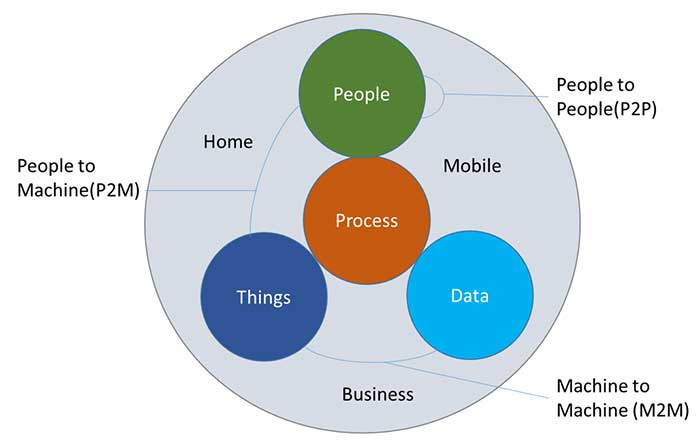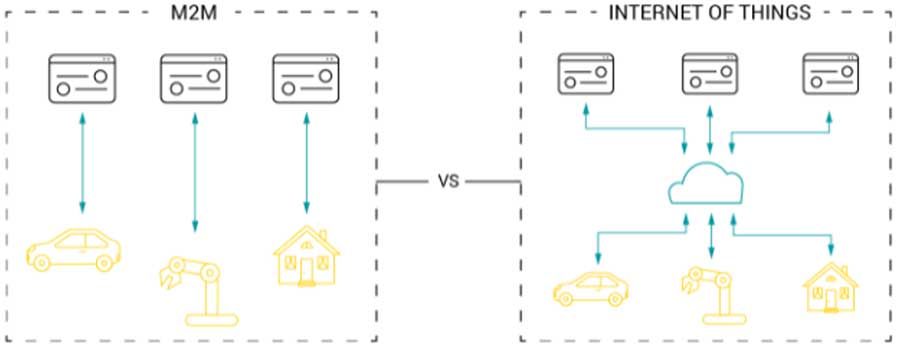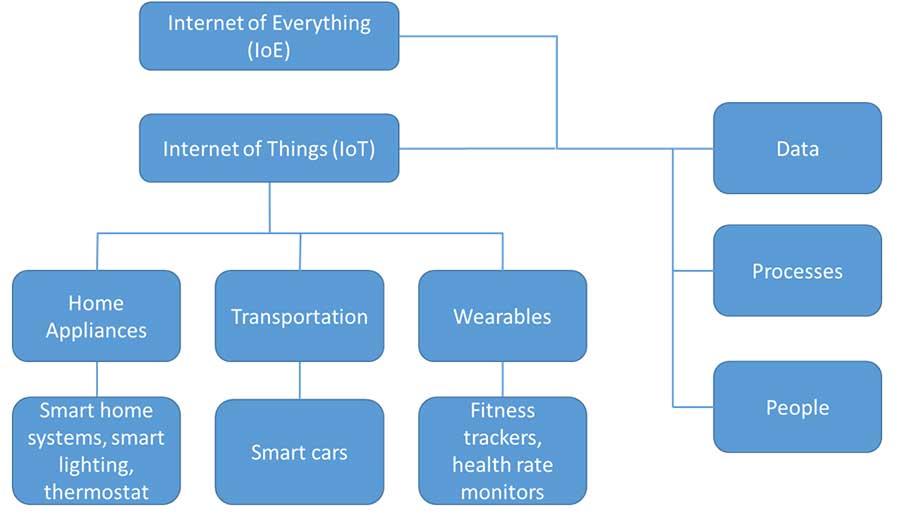Connectivity Evolution:
M2M vs. IoT vs. IoE
The Internet of Things is a network of interconnected objects or devices. IoT devices are equipped with software, electronics, sensors (or actuators), and network interfaces. These components help IoT devices communicate and share or exchange data with other devices on the network. The Internet of Things (IoT) leverages existing wired and wireless technologies and adds a framework for building networks. Therefore, the Internet of Things cannot exist independently. It has to rely on other technologies.
M2M communication allows information to be transferred between people and machines, or between machines and management systems. M2M stands for "machine to machine". M2M connections allow devices to connect to networks and freely exchange data between these resources. This communication technology does not require human interaction or intervention.
The concept of the Internet of Everything appears as a natural evolution of the IoT movement and is strongly linked to Cisco's strategy to break new ground in marketing. IoE covers a wide range of connectivity concept in terms of modern communication technologies. IoE consists of four main components that make up all possible types of communication.
People
It is considered an endpoint connected over the Internet to exchange information and actions. Examples are social media, health and fitness sensor.
Things
Physical sensors, devices, disks, and other elements that generate data or receive information from other sources. Examples include thermostats and smart devices.
Data
Analyse raw data and transform it into actionable information to enable intelligent decision-making and control mechanisms.
Processes
Leverage connections between data, objects and people to create value. For example, you can use smart fitness equipment and social networks to promote health propositions to potential customers.

Fig 1: Internet of Everything (IoE)
It is important for a technologist to understand the differences as IoT modules cover a wide range of wireless technology standards and provide a variety of features that can impact the success of IoT applications. Choosing the right wireless IoT module simplifies development, speeds time to market, and ultimately improves return on investment. The table below shows the difference between M2M, IoT and IoE.
| M2M | IoT | IoE |
|---|---|---|
| M2M is a subset of IOT | IoT is a superset of M2M | IoE is superset of IoT |
M2M encompasses three key components such as
| IOT encompasses four key components such as
| IoE consists of four key components such as people, things, data, and processes |
| Point to point communication exists between the devices | IP network exists between devices, by integrating various communication protocols | IoE is a network connection of people, data and things |
| M2M communication may exist without the internet | Devices in IoT require an active internet in most of the cases | Devices and their application require active internet |
Evolution from M2M to IoT to IoE
M2M was the standard telemetry technology for decades before the Internet was invented. This is because it was an interaction between two or more devices without human intervention. The history of M2M systems with data transmission systems began in 1845 in the Russian army. It was the heart of the wired data network. Two-way wireless networks were invented in the late 20th century. In the mid-1990s, technology moved rapidly from telephone lines to weather balloon and space telemetry.
The next generation of M2M technology was introduced in 1995 (Siemens) with the introduction of GSM data connections in cell phones. By 1997, wireless communications had matured and found countless uses, from vending machines to telemedicine. RFID technology also became popular in the mid-1990s. The development of M2M solutions based on analog connections peaked in 2010, and the technology is ready for a digital revolution.
The most recent chapter in the history of M2M systems is called the Internet of Things (IoT). The basics of hardware connections are kept, but the technology is more advanced. Cloud computing became popular in 2012 and is a major contributor to the sustainability of today’s IoT solutions. 2013 and 2014 were the first years of sensor-based IoT devices such as thermostats and home lighting. The future of M2M systems is bright as major technology companies such as Apple (launched HomeKit in 2014), Google and Microsoft are contributing to the Internet of Things.

Fig 2: M2M vs IoT
Starting from the Internet of Things (IoT) where we are today, we have just begun to enter a new field: the Internet of Everything (IoT), where things will gain context awareness, stronger processing capabilities, and stronger sensing capabilities. The addition of people and information creates network where billions or even trillions of connections create unprecedented opportunities. As the number of people, data, and communications increases, the capabilities of the Internet (basically a network of networks) increase dramatically.
Impact on Business and consumers
M2M offers many benefits to businesses. Connected devices can help you identify and eliminate inefficiencies by gathering information from every point of business, from product development to manufacturing, supply chain and point of sale. M2M solutions provide remote access to device data. This data has traditionally focused on point solutions for service management applications. The most common uses of M2M today are:
- Traffic management system that uses sensors to check variable speed and volume of traffic
- Telemetry uses sensors to measure electrical or physical data at the source; next, these measurements are converted to specific electrical voltages, a multiplexer combines the voltages into a single data stream
- Telemedicine where patients with heart disease are placed on special monitors to monitor the condition of their heart
The IoT market has much greater potential than traditional M2M due to business consolidation, greater revenue potential, and the ability to move a wider variety of devices. M2M and IoT customers want to reduce unplanned downtime, and both solutions offer the potential to improve service management. The Internet of Things provides the ability to analyse and process big data to assess these issues and improve other benefits at the system and device level.
By relying on software rather than hardware, many domestic and international customers will have access to IoT solutions. The global view feature allows you to send data from anywhere to authorized users, including mobile devices. The combination of these features increases the visibility of IoT solutions and generates interest not only at the departmental level, but also at the executive level.
The Internet of everything is reshaping the industry at three levels: business processes, business models, and business moments. At the first level, digital technologies improve the way we work with products, services, processes, customers, members, organizations and partnerships.
As companies digitise their products and processes, new ways of doing business are emerging across industries. The third level of digital reinvestment stems from the need for businesses to compete for unprecedented speed and flexibility.

Fig 3: IoT and IoE
The Internet of Everything will create millions of new objects and sensors generating data in real time. Enterprises need big data and storage technologies to collect, analyse, and store large amounts of information.IT leaders also need to make decisions to transform data from financial resources.






